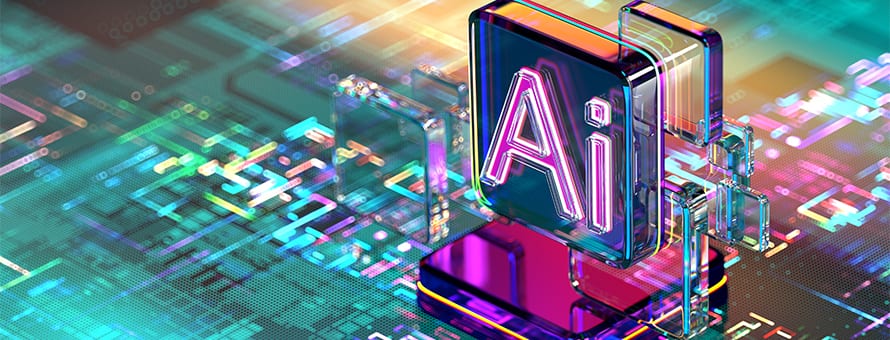What is Artificial Intelligence (AI)?

Artificial intelligence (AI) is a technology that processes information and learns from examples and patterns rather than just following exact instructions.
"AI is when computers learn to solve problems and make decisions, similar to how humans use their brains to understand the world around them,” said David Humphreys, the director of AI Integration at Southern New Hampshire University (SNHU). “Instead of just following instructions step-by-step, AI learns by looking at examples, like recognizing your voice to play your favorite music, suggesting shows you might enjoy or helping self-driving cars know when to stop or turn."
What is AI in Simple Terms?

AI is often described as a computer program that tries to think the way people do — processing information, spotting patterns and making decisions based on examples rather than instructions. “It’s a system that mimics how humans reason, but does so in ways that are faster, sometimes broader and often surprising,” said Humphreys.
Traditional AI is built to perform specific tasks like recommending TV shows or flagging spam emails. It works by learning from large datasets to recognize patterns and make predictions, he said. For example, if you show it thousands of photos of cats, Humphreys said, it can learn to spot what a cat looks like.
But it doesn’t actually understand anything — it just finds patterns and makes educated guesses based on what it has seen before, he said.
Generative AI goes a step further by creating new content instead of just analyzing existing data. These systems can produce text, images or even code based on the patterns they've learned, Humphreys said.
How Does AI Work?
![]() AI generates responses through a method similar to autocomplete, but far more advanced. "It breaks user input into smaller parts called tokens and predicts what comes next, much like how your phone suggests the next word in a text message, but on a larger, more complex scale," Humphreys said.
AI generates responses through a method similar to autocomplete, but far more advanced. "It breaks user input into smaller parts called tokens and predicts what comes next, much like how your phone suggests the next word in a text message, but on a larger, more complex scale," Humphreys said.
This process allows AI to generate responses by analyzing patterns rather than understanding meaning.
"For example, if you were to ask it, 'Describe today's weather in a literary way,' it might output, 'It's raining cats and dogs,'" he said. To generate this response, Humphreys said AI would start with the word "It's" as a token, then predict the next logical word, such as "raining," or another weather-related term.
"For each token it generates, the AI looks ahead and determines what is most likely to follow," he said. "It uses vast amounts of data to make these predictions, but the results aren’t always perfect."
Because AI operates on probability rather than comprehension, it can sometimes produce inaccurate or unexpected responses. "It might say 'It's raining meatballs,' in which case it's probably not correct," Humphreys said. This predictive nature allows AI to perform tasks, he said, but also explains why it can sometimes produce errors or unexpected outputs.
When AI provides incorrect or unrelated responses, these are known as hallucinations. According to Humphreys, hallucinations happen when an AI model produces information that is inaccurate or nonsensical. "This occurs when the model misinterprets data or generates details that were not part of the original input," he said.
Everyday Examples of AI
AI can be seen almost everywhere, from everyday tasks to highly specialized work. "AI is really all-encompassing if we're thinking about it at a high level,” Humphreys said.
It covers many different areas and includes technologies like machine learning, he noted, which has been a core part of AI systems for years, enabling computers to learn and improve from experience rather than just following set instructions. Humphreys said that common daily examples include virtual assistants that you might use every day, like Alexa, Google Home Assistant and Siri.
![]() However, recent developments in AI, known as generative artificial intelligence, create entirely new kinds of output based on your requests. According to Humphreys, generative AI takes your input and uses patterns it has learned from large amounts of data to produce responses.
However, recent developments in AI, known as generative artificial intelligence, create entirely new kinds of output based on your requests. According to Humphreys, generative AI takes your input and uses patterns it has learned from large amounts of data to produce responses.
Examples include writing answers to your questions, creating voice recordings or making videos and images based on your descriptions, he said. Some popular AI tools include:
- Code Assistants: Codeo
- Digital Avatar Creation: HeyGen, Synthesia
- Image Generation: Midjourney, DALL·E, Stable Diffusion
- Large Language Models (LLMs): ChatGPT, Claude, Copilot, Gemini, Latimer
- Music Generation: Suno
- Video Generation and Editing: Kling, Sora
- Voice and Speech Synthesis: ElevenLabs
"It seems like every week there's a new tool that fills a need that previously AI didn't touch," Humphreys said, also noting that the list of AI examples grows so quickly that it's nearly impossible to keep it complete and up to date.
What Can AI Do Better Than Humans?
AI isn't necessarily smarter than humans, but it can do certain things much faster. "The big thing that AI has that humans don't is speed," he said. "You could ask it to output an entire piece of software, and it could do that in a short amount of time. Would the software run? Would it be coded well? Those are two completely different questions, but it would output code very quickly."
It can handle large tasks in seconds or minutes that might take you hours or days. AI can be great at repetitive or tedious tasks, helping you save time by summarizing long meetings, drafting emails or proofreading writing, he said.
"AI tends to do much better with concrete tasks, particularly around domains like knowledge gathering, math and coding," Humphreys said.
What Are the Real-World Uses of AI?
AI can be best used as an assistant, helping you with tasks that are repetitive or take a lot of time.
"The best way most people can use AI is thinking about it as an assistant, having it work on things that are time-consuming or that you don't like to do,” Humphreys said. “By using AI in that way, you're not undermining your own creativity."
Using AI to organize your thoughts can help you clearly outline ideas, spot gaps and save time planning or structuring your work. “I'll turn on voice mode on ChatGPT and I'll talk to it,” he said. “And then at the end, I'll just ask it to create a summary of the ideas I had or to help me flesh out an idea.”
However, AI struggles with creativity. "Creativity is something that's uniquely human," Humphreys said.
AI tries to copy creativity but can't fully capture it. "If you ask it for a poem, it will write a poem,” he said. “Is it going to be a good poem? Probably not compared to a poet laureate or somebody who has written poetry."
AI might seem very creative if it's working in an area where you're not as skilled. But it's still only imitating human creativity, not truly being creative on its own, he said.
If you're interested in learning AI you can start by trying out and researching AI models. "Play around with them,” Humphreys said. “Figure out the ones that connect with you, whether that's (with) your ethics, your values or just the output of the model."
Commonly Asked Questions About AI
Here are a few questions you might have about artificial intelligence.
Are Some AI Models More Ethical Than Others?
Yes, different AI models prioritize ethics in different ways, such as reducing bias or improving transparency, said Humphreys. "(Claude AI) has constitutional AI, which is a way of defining how the AI interacts with information for the user and within the kind of experience itself."
Latimer is an AI model based on an older version of ChatGPT, specifically trained to promote cultural inclusivity, with a focus on representing the Black experience, he said.
While some models, like DeepSeek, raise concerns due to how they handle and share information, Humphreys said.
What is Machine Learning?
Machine learning (ML) is a foundational approach in artificial intelligence that allows computers to learn from data and make decisions. It’s like teaching a computer to recognize patterns by giving it examples, he said. "Think of it like teaching a dog tricks with treats: the dog starts recognizing what behaviors get rewards."
What is Deep Learning?
Deep learning is a subset of machine learning that uses multi-layered neural networks to solve more complex problems. “It’s like the overachiever of the ML family,” Humphreys said. Instead of being told what features to look for, deep learning models figure it out on their own — especially useful for tasks like recognizing faces or generating text, he said.
What is Artificial Narrow Intelligence?
Artificial narrow intelligence (ANI) refers to the kind of AI we use today, designed to perform well at a limited set of tasks. It’s effective at things like generating text, creating images or writing code — tools like ChatGPT and Google Gemini are examples, Humphreys said. But for any task these systems can handle, there are still people who can do it better, he said.
What is Artificial General Intelligence?
Artificial general intelligence, or AGI, is a hypothetical form of AI that would outperform humans at nearly every task. “That would range from driving cars to math to programming to whatever,” Humphreys said.
While AGI doesn’t exist yet, many believe it could arrive within the next five to ten years, though we don’t know how big of a disruption it’s going to be, how expensive it’s going to be to use, or who’s going to have access to it if it arrives at all, he said.
Education can change your life. Find the SNHU artificial intelligence course that can best help you meet your goals.
Ollie Burkett is a writer at Southern New Hampshire University, where he is pursuing his Master of Arts in English and Creative Writing. You can connect with him on LinkedIn.
Explore more content like this article

How to Learn Artificial Intelligence (Plus Helpful Courses and Skills)

Telling Stories With Numbers: How to Become a Data Analyst

How SNHU Grad Cyndie Ramirez Built Her Second Career in Cybersecurity
About Southern New Hampshire University

SNHU is a nonprofit, accredited university with a mission to make high-quality education more accessible and affordable for everyone.
Founded in 1932, and online since 1995, we’ve helped countless students reach their goals with flexible, career-focused programs. Our 300-acre campus in Manchester, NH is home to over 3,000 students, and we serve over 135,000 students online. Visit our about SNHU page to learn more about our mission, accreditations, leadership team, national recognitions and awards.

